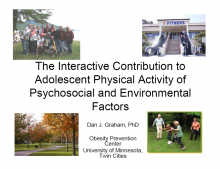We are pleased to announce an exciting new alliance between Active Living Research and GP RED to co-host and coordinate...
The Interactive Contribution to Adolescent Physical Activity of Psychosocial and Environmental Factors

Presentation at the 2010 Active Living Research Annual Conference
Background:
The body of literature examining the independent contributions to physical activity (PA) made by various environmental and psychosocial variables is substantial and is helping practitioners make great strides toward promoting health and preventing obesity. An area of research that could significantly aid this effort yet remains underexplored involves examining together both psychosocial and environmental variables to understand their interactive effects on PA. This ecologically valid pursuit can help investigators better understand the ways in which multiple influences combine to impact health among free-living populations.
Objectives:
The primary hypotheses tested in this study were that 1) psychosocial resources (perceived competence for PA and social support for PA from family and friends) would be associated with PA and physical fitness in a sample of 192 adolescents (mean age 14.79 ± 0.46 years; 55% male); 2) environmental access to PA resources (gyms, schools, trails, parks and athletic fields) would also be related to adolescent PA and fitness; and 3) the interaction between psychosocial and environmental variables would be associated with PA and fitness.
Methods:
PA assessments included Actigraph® accelerometer (data collected for 7 days), 3-day PA recall (3DPAR), and self-reported sports participation (in school and out of school). Perceived competence for PA was assessed via the “competence” subscale of the Intrinsic Motivation Inventory (IMI; Ryan, 1982, see also McAuley, Duncan, & Tammen, 1989); this subscale contains 6 items that ask respondents to rate statements such as “I think I am pretty good at exercising” on a 7 point Likert scale: 1 (not at all true) to 7 (very true). Family support for PA was measured using a 5-item scale (Prochaska, Rodgers, & Sallis, 2002) on which a respondent indicates the frequency “in a typical week” that a member of their household “played sports with you,” or “provided transportation to a place where you can do physical activities or play sports.” Friend support for PA was also measured using a 5-item scale taken from Prochaska et al., 2002. Adolescents completed items such as “Do your friends encourage you to do physical activities or play sports?” Response options for both scales ranged from 1 (none) to 5 (every day “during a typical week”). For all analyses, family and friend support for PA were combined as a single social support for PA variable.
Environmental access to PA resources was determined via GIS-based assessment of the number of environmental PA opportunities (gyms, schools, trails, parks and athletic fields) within .5 miles of each participant’s home. Physical fitness was assessed via maximal oxygen uptake (VO2peak) during a ramp-type cycle-ergometer test of aerobic fitness, percent body fat determined via dual energy x-ray absorptiometry (DEXA), and body mass index (BMI) percentile. Sociodemographic covariates in all analyses included participant age, gender, ethnicity, and socioeconomic status.
Results:
Perceived competence for PA significantly predicted all of the PA and fitness variables at the p<.05 level. Social support for PA significantly predicted all of the PA variables and also physical fitness as measured by VO2 peak. Greater environmental access to PA resources significantly predicted higher levels of physical fitness (as assessed via BMI percentile and percent body fat) among male, but not female, participants. For females, but not males, greater environmental access to PA resources significantly predicted more involvement in PA (as measured by school sports participation).
Environmental resources significantly moderated the association between social support for PA and school sports participation, such that adolescents with high levels of both social support and environmental resources were more involved in school sports than were adolescents with low levels of social support, low levels of environmental resources, or both.
Conclusions:
As hypothesized, the psychosocial variables (social support and perceived competence for PA) were independently associated with both PA and fitness in this sample of adolescents, and all in the expected directions - those adolescents with more support for PA and greater perceptions of competence were more physically active and fit. Environmental access to PA resources was associated with PA and/or fitness; however, the ways in which the environment was related to adolescent PA and fitness depended on gender. These gender differences are intriguing and may be related to differences in parental monitoring, adolescent exercise motivation, and/or other factors. The finding that environmental PA resources moderated the relationship between social support for PA and school sports participation among adolescents suggests that PA-promotion interventions should aim to enhance both social support and environmental resources - targeting either one on its own may be insufficient. The combined influence of psychosocial and environmental factors on PA is an area that merits investigation.
Support:
This research was supported by NICHD grant RO1HD037746 awarded to the second author and a UC Irvine Dean’s Dissertation Fellowship awarded to the first author.
STAY UP TO DATE
RECENTLY ADDED TOOLS & RESOURCES
MOVE! A BLOG ABOUT ACTIVE LIVING
The "Active Living Conference" aims to break down research and practice silos and...







